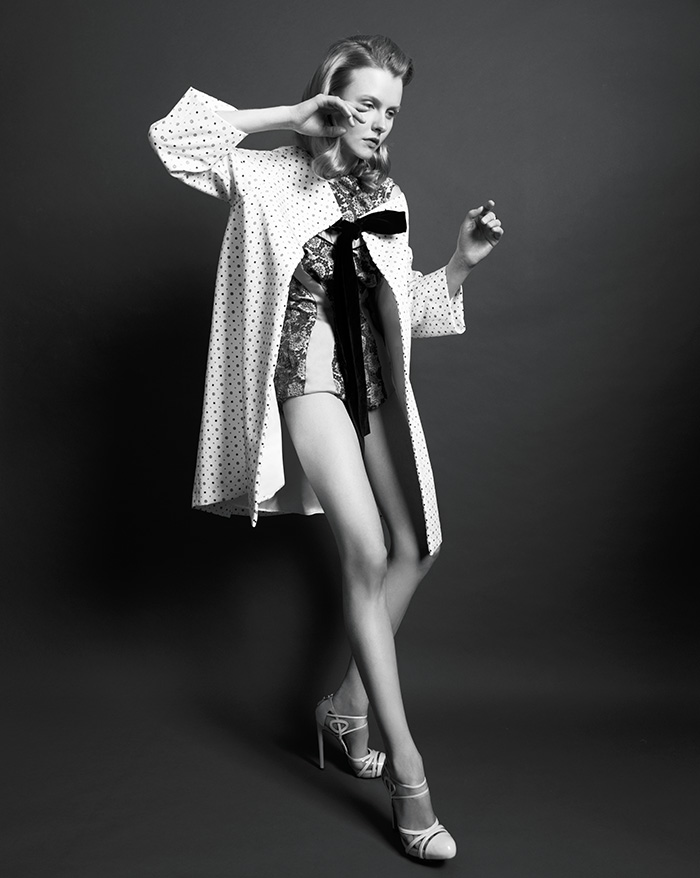Kamila Filipcikova was discovered at the age of 14 in her hometown Bratislava. Since then the slovakian girl made it on the cover of Vogue Italia and danish Rodeo Magazine, worked together with Juergen Teller and Steven Meisel and appeared in editorials for magazines such as W, Cover and Love Magazine. Having that in my mind it's quite surprising getting to know her in her outstanding appearance. Outstanding - in a very down-to-earth way. We met Kamila for a talk about the ego from the view of a full-time-model, her experiences and the craving for the simplest things in life. The fact that we had to capture her (superficial) beauty trough a photo series aswell becomes unquestionable.
Read the whole interview after the jump.
Where are you from?
I was born and still live in Bratislava, the capital of Slovakia. We have a big family — I’m the oldest of seven children.
What is Slovakia like?
I love road trips with no planned route. As a child we went hiking in the mountains and when I got older I would spent weeks there with my friends — camping and visiting art festivals in the middle of nowhere. It was so simple, yet beautiful. My fondest memories are connected with nature and people from my country. They are a bit reserved but very welcoming. When I travel I miss this kind of real life stereotype that you normally want to escape from.
At the age of 15, but at first it was a joke. I never believed modeling would work out. My parents were completely against the business so I kept sneaking around, more or less just to make them angry. I didn’t feel pretty at all. No one in my field does.
They were very different. I shot with Steven at the very beginning of my career. It was my first big break, and, honestly, I’m ashamed to say it, but at that time I had no idea what was going on or who he was.I flew with a backpack full of dirty clothes to L.A. It was November, but over there it was all sun and heat and there’s me with my ugly winter clothes on — you got the picture? A limousine was waiting for me at Arrivals. Yes, for me. The tired, shitty-looking kid from mid-Europe. The five-star hotel on Sunset Boulevard didn’t want to check me in because I had no credit card, only a student account card that had a limit of 40 dollars. Finding my washed socks all around the bathroom was probably a surprise for the cleaning woman. The shoot itself was amazing — far away from all the shoots I had experienced before. It felt like being in a movie. Steven himself was quiet, very polite, and respectful. The set was built, and he let us in and allowed us to play out the way we felt about the theme of the shoot. He wanted us to stimulate his imagination. The shoot with Juergen Teller came much later. I was more experienced, but more stressed as well. It was an intense shoot, many people, different locations, fast-paced, and with a very different energy. Most of the pictures he took looked like they were done by accident, but there is a lot of work behind them. You are not able to catch that by looking at them superficially, only if you were a part of it.
It’s not me, it’s an illusion — an imagined version of someone’s picture of someone. I am just there to give structure to a prefabricated fantasy.
It’s a question of creativity, what you can implement with your style using all different kinds of art to connect at this one point. It is the projection of yourself to the audience. It is the first thing other people are able to see. But the so-called
“fashion world” doesn’t matter to me. I think you can see this in my way of dressing.
My job is to be able to convince others. During a shoot it works out pretty well. It took me some time before I got used to behaving normally and was able to forget about all the people watching me on the set while I was wearing make-up and styled with some
weird hair-do. But I, Kamila, can hide behind a new character. Anonymity matters to me. I keep my business miles away from my ordinary life.
I am sure it did, in many different ways. Everything you touch leaves some marks, sometimes regrettably. If I can count one thing that’s definitely a good change, I was always late before my modeling career — that needed to be improved.
A while ago, I found I have a passion for cooking. I can spend hours in the kitchen and I am planting herbs, peas, and tomatoes on my balcony. I was thinking of how nice it would be to have chickens as well, but I guess the neighbors would kill me. I don’t have
definite plans for the future. The few things I might dream of need to wait anyway.
Interview: Zsuzsanna Toth
Photos: Stefan Heinrichs
Fashion: Kathi Kauder
Hair & Make-Up: Stelli using Tom Ford Cosmetics
Model: Kamila Filipcikova @ elite model management London
PHOTO Assistant: christian rinke
Fashion Assistants: Fernando Torres, Emily Gessner





0 comments:
Post a Comment